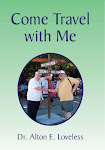Merry CHRISTmas and a blessed 2008th
"Christmas waves a magic wand over this world, and behold, everything is softer and more beautiful," remarked the famed Dutch Reform preacher Norman Vincent Peale.
But for only for a few weeks the spirit of Christmas lasts--that special feeling of love and brotherhood that affects the world at Christmastime. For one glorious month, feuds are forgotten, grudges go on the back burner, and everyone adopts a spirit of friendship and cooperation.
Then it's gone. When the whistle sounds on the last New Year's Day bowl game, life gets "back to normal." Workplace worries bring stress, tension, and the disunity that so often infects everything. However, Alexander Smith reminds us that, ”Christmas is the day that holds all time together."
Mary Ellen Chase said, "Christmas is not a date. It is a state of mind."
This year, let's resolve that Christmas is not just a season, but a state of mind. Let's permit the love that was in Christ Jesus, be in each one of us. Let's sacrifice for others, be tolerant of their mistakes, and keep their best interests at heart. Christmas doesn't have to be a once-a-year event. It can be a lifelong passion, a lifestyle of love that says to others "You matter to me."
Many have a single object--to make it to the top! Money, resources, and even people, become tools to be used in the pursuit of success. Climbing the ladder, punching tickets--whatever it's called, the goal of the game is always the same: to be king of the hill.
Jesus took a different route.
He didn't climb up; he stepped down. He wasn't after the chair at the head of the table; he took the lowest place. By being born as a helpless baby and placed in a manger, Jesus Christ demonstrated the most potent lesson of all time: the way up is the way down. If we are to help others best when we should first be willing to serve.
1. Nowhere is Strength found better that in what many call a Weakness.
Herod's soldiers were sent to kill the helpless Christ-child, but they failed. God's plan may have seemed foolish, sending the Savior of the world in the form of a helpless child. But here as always, his strength was made perfect in weakness. The child rose to be king. I am constantly reminded by Helen Keller, who was both deaf and blind, who said, "The only real blind person at Christmas-time is he who has not Christmas in his heart."
2. Good servants will Know Their People.
Jesus left the splendor of heaven to live within the confines of a human body. By doing so, he did something that had never been done--not even thought of--before. He brought God and man together.
Human beings can't be helped by remote control. Servants must be among them, talk to them, and learn from them. Building friends is necessary to gain their confidence in you. If Jesus saw the need to step down from heaven, certainly we must be willing to step out from that which governs us, and spend some time among those whom we have the privilege of sharing His grace.
3. The only thing at the top is nothing.
Seeking to help others know the real action is never at the top, but at the bottom. Politicians know that public opinion counts more than any summit. Business leaders know that buying habits, not boardroom decisions, are what make their bottom line. Remember the words of Benjamin Franklin, "How many observe Christ's birthday! How few, his precepts! O! 'tis easier to keep holidays than commandments."
"Give to others, and you'll receive something really special this Christmas—love," says, my friend, Stan Toler. He further states, "We celebrate Christmas best when we give to those who need the most."
People should be the goal of your servanthood. If you want to be a great servant, you must love people more than you love power, prestige, or perks. If you finally do "get to the top," you'll probably find that it's a lonely place without the love and respect of others. "Christmas began in the heart of God. It is complete only when it reaches the heart of man." --Anonymous
4. People who do something in life learn to move out and forward.
Jesus didn't stay in the manger. Because he was willing to humble himself, he was given the position of highest authority. There's a U-turn at the bottom of self-sacrifice. When we truly humble ourselves, we are exalted in the eyes of God and others.
If you are a true servant, your sacrifice will not be in vain. You will accomplish your goals for your church, your organization, your people, and--most important--for the Lord. Don't be afraid to give yourself away. There's a bend in that lowly road that leads to heaven. "God is with us. That's the best news I've heard all year!" writes Stan Toler.
I'm praying for you--for your family and your church and your job--praying that Dec. 25 was the first day of a brand new year!












